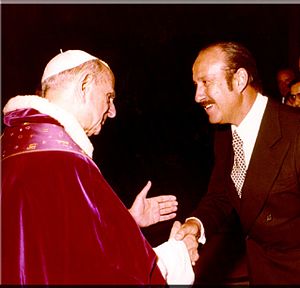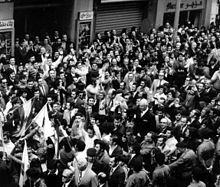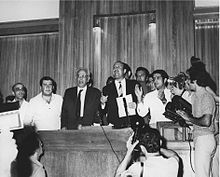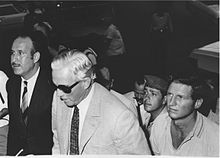- Michel Georges Sassine
-
Michel Georges Sassine 
H.E. Michel Sassine with Pope Paul VI Vice Prime Minister Deputy Speaker of Parliament Minister of Labor Minister of Tourism Minister of Housing and Cooperatives Member of Parliament Personal details Born Achrafieh, Lebanon Political party Independent Religion Greek Orthodox Michel Georges Sassine (Arabic: ميشال جورج ساسين) is a prominent Lebanese politician. He was a member of the Lebanese parliament for twenty-four consecutive years (1968–1992) representing the district of Ashrafieh, Beirut. He served several times as Vice-Prime Minister, Deputy Speaker of Parliament, and cabinet Minister. He founded the Ministry of Housing and Cooperatives, and was appointed as Minister of Labor, Tourism and others.Throughout his political career he was renowned for his strong ethics and anti-corruption principles. He took the lead on several historic turning points including the 1970 Presidential election,[1] and the Taif Agreement in 1990.[2]
Contents
Personal life
Sassine was born to a prominent Greek Orthodox family in Ashrafieh to parents Georges Sassine and Laurice Bustros. He lost his father in his teenage years and found himself in the responsibility of four other siblings including new-born twins. Sassine went to lead his family into politics, and together with his brothers Pierre and Joseph dedicated the family’s efforts to public service.
1968 Parliamentary elections
Michel Sassine was first elected to the Lebanese Parliament in 1968 running for the Greek Orthodox seat in the nation’s capital Beirut. Sassine ran alongside Nasri Maalouf and together, as independents, won against the government-backed coalition lead by Sheikh Pierre Gemayel - including Minister of Foreign Affairs Fouad Boutros.
 Michel Sassine and Nasri Maalouf winning 1968 elelctions
Michel Sassine and Nasri Maalouf winning 1968 elelctions
1970 Presidential elections
 Deputy Speaker Michel Sassine declaring Suleiman Franjieh President of Lebanon in 1970
Deputy Speaker Michel Sassine declaring Suleiman Franjieh President of Lebanon in 1970
In the closest and possibly most controversial presidential election in Lebanese history, Sleiman Frangieh was elected President of the Republic by the National Assembly on August 17, 1970 with a majority of one single vote. The presidency being the most powerful political institution in pre-1990 Lebanon the presidential race was of particular importance as it came after 12 years of continuous Shihabist rule (Fuad Shihab 1958-1964, and Charles Helou, 1964–1970). The two main opposing candidates emerged to be Elias Sarkis – then Governor of the Central Bank – backed by the Shihabi regime; and Sleiman Frangieh backed by the opposition. [3]
On the third voting round, Frangieh received majority by a single vote over Elias Sarkis. Sabri Hamadeh, then Speaker of Parliament and supporter of the Shihab regime, refused to announce the election of a President on such a low margin, and walked out of Parliament. Michel Sassine, Deputy Speaker of Parliament, stepped up and assumed the responsibilities of Speaker and announced Frangieh President in a move that saved the country of an inevitable political vacuum. [4],[5], [6]
(See two additional pictures of Sassine announcing Frangieh President:[7], [8])
Sassine moved to serve as Minister and Vice-Prime Minister in the four different governments between 1972-1975 under the mandate of President Frangieh.[9]
His relationship with President Camille Chamoun
Michel Sassine initially got elected as an independent and was never part of any political party throughout his career. Nevertheless, he developed a close political and personal relationship with President Camille Chamoun, and took a leading role in the National Liberal Party (Lebanon) (Al Ahrar) parliamentary block until the death of Chamoun's son Dany in 1990.
Role in Taif Agreement
Sassine was a signatory of the Taif Agreement that ended the Lebanese civil war [10]. He was serving as Deputy Speaker of Parliament when Parliament signed the agreement on October 22, 1989 and ratified it on November 4, 1989. In the post-Taif period Sassine was appointed Vice-Prime Minister and Minister of Labor in both the 1990-1992 governments of Salim al-Hoss, and Omar Karami.[11]
Other Achievements
- Exercised full powers of Vice-Prime Minister and Deputy Speaker of Parliament: as Sassine occupied the highest positions allocated to Greek Orthodox in the Lebanese sectarian system he remains one of the few to have exercised the full power of these offices, as they remain symbolic otherwise. Other than his role in the 1970 Presidential elections, he acted as Speaker of Parliament on numerous occasions and lead parliament on many junctures to pass significant reforms. Sassine’s ability to exercise the Greek Orthodox Deputy responsibilities was due to both strong political backing and personal character.
- Saved 13 Lebanese from execution in Guinea: in the early 70’s thirteen Lebanese were sentenced to death in Africa’s Guinea in an attempted coup against President Ahmed Sekou Toure. As the execution order was to be carried a week after their arrest, and many mediation efforts for their release failed, President Suleiman Frangieh tasked Michel Sassine, then Vice-Prime Minister, on an urgent diplomatic mission to Guinea. Sassine succeeded in his intervention as Sekou Toure agreed to issue a Presidential pardon and handed all thirteen Lebanese detainees to Sassine to bring back to Lebanon. [12],[13]
Association to Sassine Square
Sassine Square in Ashrafieh - the biggest and oldest square in Beirut – is one of the most prominent political, social and commercial focal points of the Lebanese capital.[14] While Sassine Street was named after Michel Sassine’s father Georges in the 1940s’, Michel Sassine moved to get Sassine Square officially inaugurated in the early 90’s under the auspices of President Elias Hrawi and Prime-Minister Rafic Hariri.[15],[16]
Lebanon 
This article is part of the series:
Politics and government of
LebanonPresidencyGovernment- Prime Minister
- Cabinet
Legislature- Parliament
- Current members
- Presidential 2008
- Parliamentary 2009
- Local 2010
Other issues- Governorates
- Districts
- Municipalities
- Armed Forces
- Human rights
- Foreign relations
References
Further reading
- Michel Sassine biography (Arabic Version): http://www.scribd.com/doc/53686385/Michel-Sassine-Biography-draft-version
- Background notes on Lebanon and list of 1990 government ministers http://dosfan.lib.uic.edu/ERC/bgnotes/nea/lebanon9012.html
- Two additional pictures of Deputy Speaker Michel Sassine announcing the election of Sleiman Frangieh as President of Lebanon in 1970: http://img163.imageshack.us/img163/7387/sassinefranjieh.jpg , http://img573.imageshack.us/img573/6040/michelsassinevssabriham.jpg
- Documentary on Camille Chamoun in 39 episodes - see Michel Sassine throughout episodes 26 and beyond http://www.youtube.com/watch?v=WSnl-iFWY2w
- See video of Parliament voting on Taef Agreement, including Sassine at http://www.youtube.com/watch?v=nHGJymb_PiM
- Three articles on Sassine Square: http://www.assabil.com/documents/pdfs/ASSABIL_SassRep2_preview.pdf; http://www.aawsat.com/details.asp?section=41&article=593622&issueno=11663; http://www.yabeyrouth.com/pages/index3646.htm
- See Michel Sassine in Who's who in the Middle East and North Africa [17]
Categories:- Government ministers of Lebanon
- Members of the Parliament of Lebanon
- Greek Orthodox Christians from Lebanon
- Eastern Orthodox Christians from Lebanon
- Arab Christians
- Lebanese Christians
- Lebanese politicians
Wikimedia Foundation. 2010.


